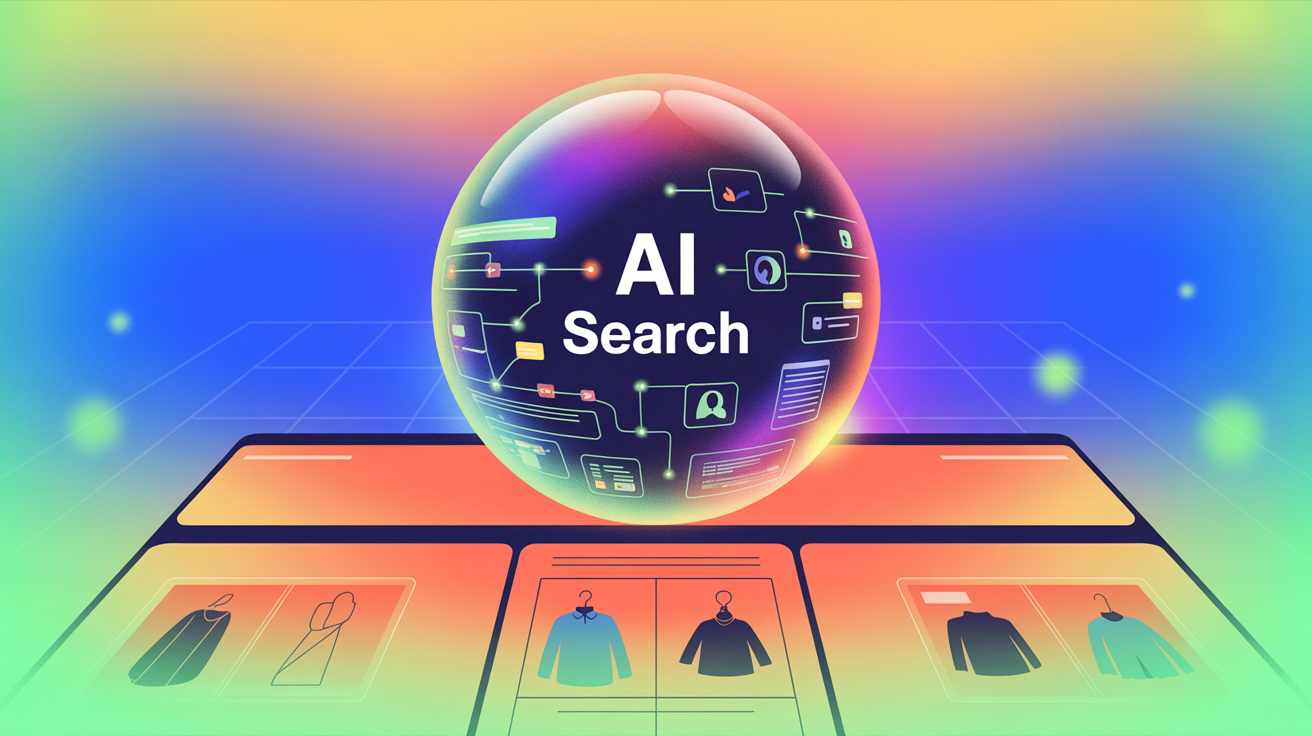AI search as the next frontier for ecommerce SEO
Written by
Kinga EdwardsPublished on

Search in ecommerce has always been about speed and relevance. But in 2025, the definition of “search” itself is shifting. Instead of scrolling through endless product grids or typing keywords into a search bar, shoppers are increasingly turning to AI-powered tools—voice assistants, chatbots, and visual search engines—that understand intent, predict needs, and return answers in real time.
AI search is reshaping how products are discovered, how ecommerce SEO is measured, and how marketing strategies are planned.
The market is moving – fast
The numbers make the trend hard to ignore. The AI-enabled ecommerce market is worth $8.65 billion in 2025, projected to grow to as much as $22.6 billion by 2032. That’s a compound annual growth rate of up to 24.34% depending on the research source.
- 89% of ecommerce companies are already using or testing AI in their operations.
- 97% of retailers plan to increase AI investments in the next 12 months, shifting from experiments to full-scale integration.
- Retailers report that AI-powered search and conversational tools deliver a 4x jump in conversion rates—12.3% purchase rate with AI vs 3.1% without.
It’s not just about better recommendations or faster answers. AI search changes where and how customers encounter your products. And that’s where ecommerce SEO strategies need to adapt.
Why AI search is different from traditional search
Classic ecommerce SEO focused on keyword optimization, structured product data, and ranking in search engine results pages (SERPs). AI search changes the playing field in several ways:
- Intent understanding: AI interprets queries contextually. “I need a waterproof jacket for hiking in Iceland in March” isn’t reduced to a few keywords—it’s parsed for location, weather conditions, activity type, and even seasonal patterns.
- Multi-modal queries: Customers can upload a photo, describe a product verbally, or share a screenshot, and AI will return matches. Amazon alone sees over 4 billion shopping-related visual searches per month via Google Lens.
- Conversational journeys: Shoppers interact with AI receptionists in a back-and-forth dialogue, refining preferences as they go. The “search” is a conversation, not a static results page.
- Personalized recommendations at scale: Returning customers using AI features—chat, recommendations, or virtual assistants—spend 25% more per order on average.
For ecommerce marketers, this means the visibility battle is no longer limited to Google’s top 10. It extends into AI-driven overviews, chatbot suggestions, and product carousels inside messaging apps and smart devices.
The double-edged sword: AI overviews and traffic shifts
Google’s own AI-generated summaries (“AI Overviews”) now appear in 47% of search results, and for 58% of informational queries.
That’s great for users who want quick answers, but it’s a double-edged sword for retailers:
- On one hand, if your product data and content feed into these AI-generated results, you can reach customers faster and more directly.
- On the other, early reports suggest organic traffic can drop 15–25% when AI overviews answer the question without requiring a click.
In practice, this means ecommerce SEO strategies should account for both ranking in traditional results and being present in AI-driven contexts—whether that’s through optimized structured data, strong brand presence, or direct integrations with AI platforms.
AI search and ecommerce personalization
Personalization has been a marketing buzzword for years, but AI search is turning it into a conversion engine. Companies that excel at personalization can generate up to 40% more revenue, according to recent studies.
Here’s how AI-powered search makes that possible:
- Dynamic product recommendations based on browsing history, previous purchases, and real-time preferences.
- Localized results that factor in delivery times, regional pricing, and stock availability.
- Adaptive content that changes product descriptions, imagery, or order in the search results depending on the customer segment.
For example, a customer searching for “running shoes” might see trail shoes if their location suggests outdoor terrain, or lightweight racing shoes if recent purchases indicate competitive running.
What fits into AI-era ecommerce SEO
Adapting to AI search doesn’t just mean rewriting product descriptions or adding more images—it requires deep visibility into how your brand appears across both traditional and AI-driven discovery channels.
Ahrefs, long known for its SEO capabilities, now extends and becomes Ahrefs marketing platform to support exactly this kind of multi-surface visibility:
- Brand & AI Search lets you track brand mentions, citations, and sentiment across AI chatbots and assistants—crucial for knowing how (and where) your products are recommended in AI-generated answers.
- Competitive Intelligence reveals the PPC strategies and content plays your competitors are making, helping you anticipate shifts in AI search visibility.
- AI Content Helper and AI Content Grader can streamline content creation and optimization for the types of rich, context-aware queries AI thrives on.
- Rank Tracker now goes beyond classic rankings, helping you understand how you perform in localized and conversational search contexts.
By combining these insights, ecommerce teams can not only react to the AI shift but plan for it—allocating resources where the visibility gap is greatest.
The opportunities ahead
Ecommerce brands willing to adapt to AI search early stand to benefit in several key ways:
- Owning the AI shelf space. Just as top positions on Google became prime real estate, the first few product suggestions in an AI assistant carry outsized influence. Early adopters can build lasting brand associations in these new environments.
- Shorter conversion paths. AI search reduces hesitation. With a 47% faster purchase completion rate among AI-assisted shoppers, ecommerce stores can shorten the funnel and increase order volume without extra ad spend.
- Cross-channel intelligence. Tracking mentions across AI tools, search engines, and social platforms creates a fuller picture of brand presence—critical for integrated marketing strategies.
- Higher repeat purchase rates. By integrating personalized AI recommendations into the post-purchase experience, brands can lift customer lifetime value and deepen loyalty.
Steps ecommerce teams can take now
If you’re planning to adapt your SEO strategy for the AI search era, here’s where to start:
1. Audit your product data
Make sure product feeds, structured data, and metadata are clean, consistent, and enriched with context—size guides, materials, use cases, compatibility details.
2. Monitor AI search visibility
Use tools (like Ahrefs’ Brand & AI Search) to see how your brand is appearing in AI-generated answers. Identify where you’re absent, and what competitors are doing differently.
3. Optimize for multi-modal queries
Invest in high-quality product photography, video, and rich media that can power visual and voice search. Include descriptive alt text, captions, and transcripts.
4. Personalize beyond the homepage
Integrate recommendation engines into category pages, search results, and even checkout flows. AI works best when it’s embedded throughout the customer journey.
5. Build for speed and relevance
AI search rewards fast-loading pages and relevant answers. Site auditscan highlight technical SEO issues that slow down performance.
The risk of waiting too long
AI adoption in ecommerce isn’t slowing down—97% of retailers plan to increase investment in the next year. This means the competitive baseline is rising. Brands that wait risk:
- Being excluded from AI-generated product recommendations.
- Losing organic visibility as AI overviews dominate the top of search results.
- Falling behind on personalization, which customers increasingly expect as standard.
The gap between early adopters and late movers is likely to widen fast, especially as AI systems learn from historical data and interactions. If your competitors are already feeding data and content into AI platforms, they’re shaping future recommendations in their favor.
Final thoughts
AI search isn’t replacing ecommerce SEO—it’s expanding it. The skills that helped brands rank in traditional search results still matter, but they need to be adapted to a world where the “first page” might be a chatbot conversation, a voice assistant’s shortlist, or a visual match on someone’s phone.
For ecommerce brands, the frontier is wide open. Those that combine strong product data, agile content strategies, and the ability to monitor AI search presence—using platforms like Ahrefs—will have the best shot at owning the next generation of product discovery.
The challenge now is simple: don’t just optimize for where shoppers are today. Optimize for where they’re headed next.


